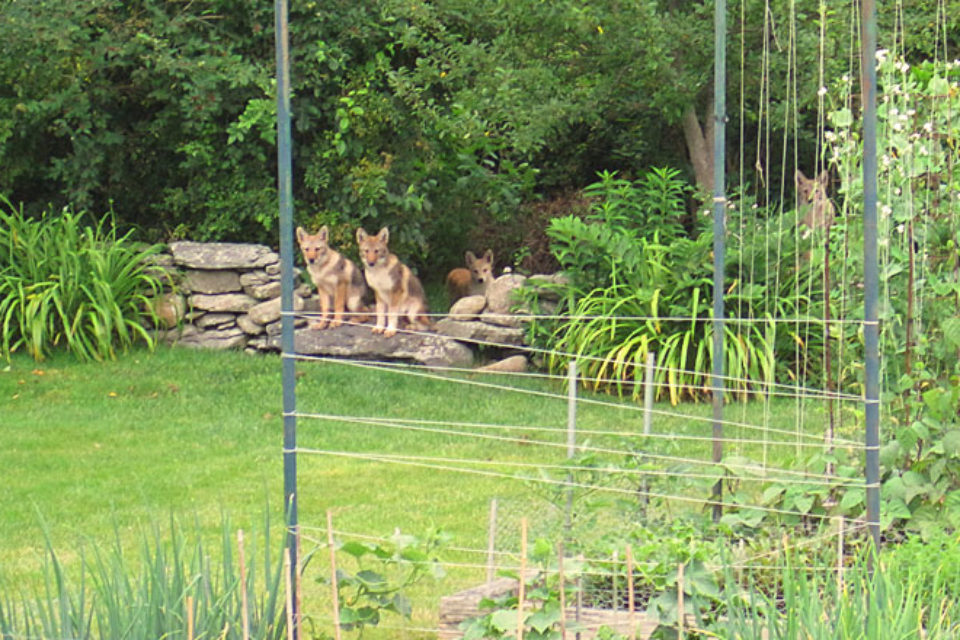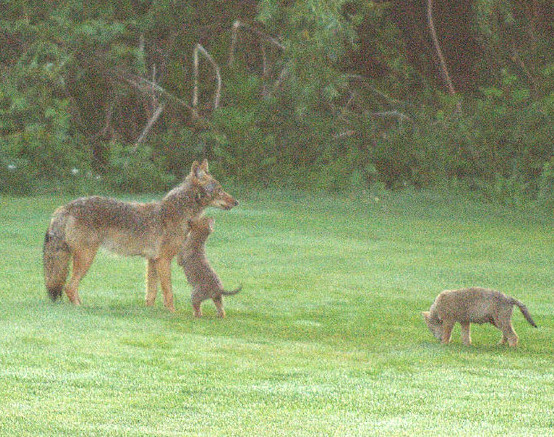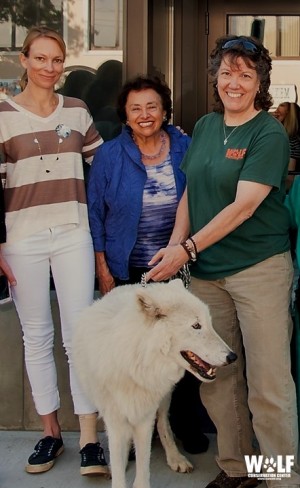Coyote Talk with Maggie Howell of the Wolf Conservation Center

When you bought your home did your realtor tell you that you would be living on coyote property? Facing the reality that you may be sharing land with a coyote family may be difficult for residents concerned over the news of coyote attacks on small dogs in our area. Maggie Howell, the Executive Director of the Wolf Conservation Center in South Salem, thinks a better understanding of coyote behavior can go a long way in minimizing risks and managing any anxieties you may have.
Maggie, what are all those coyotes doing in our back yards?
Mostly they’re just passing through. Coyotes do not migrate. They are yearlong residents and typically inhabit an area known as a home range. So if you see one in your yard, you’re on their land. Coyotes tend to be seen in the spring during puppy season when they seek out dens to care for their pups and the male ventures out to find food  for the whole family. Don’t help them out by leaving food outside or in open trashcans. Don’t feed the neighbors cats. And remember that if you have bird feeders in your yard, the seeds attract rodents and the rodents attract coyotes. Let them find their own food in the woods.
for the whole family. Don’t help them out by leaving food outside or in open trashcans. Don’t feed the neighbors cats. And remember that if you have bird feeders in your yard, the seeds attract rodents and the rodents attract coyotes. Let them find their own food in the woods.
Have any population control programs been successful?
Coyotes are one of the most successful carnivores in North America because of their ability to cope, if not thrive, in the face of human-caused changes to the environment. Adaptable, charismatic, and resilient, coyotes are a natural part of the landscape. Although they provide ecological benefits in both rural and suburban environments, most states attempt to reduce coyote populations via public hunting and trapping seasons, killing contests, and even bounties. Wildlife Services, a branch of the USDA, kills thousands of coyotes annually via poisons, traps, aerial gunning, and more. And yet coyotes continue to thrive in more and more places across the continent. Indiscriminate killing is counterproductive and can, in fact, increase populations of the canid species. Coyotes live in family units like we do. If you kill a coyote, the family structure is broken. Without oversight from the coyote parents, you have single and naïve coyotes roaming looking for partners. If we take the time to better understand the behavior and benefits of coyotes, instead of jumping to remove the animals, we can have better success of reducing conflict.
Why are some people so frightened by them?
People in suburbs are not accustomed to seeing predatory wildlife. Many tend to fear the new or unknown. And swayed by fear, people think coyotes are a lot bigger than they really are. Your typical eastern coyote is the size of a border collie, about 35-45 pounds. Coyotes are usually more fearful of us than we are of them.
Are they dangerous to humans?
 Not typically. The good news is that they usually try to avoid humans, coming out only when they think we’re not around. But if they do become aggressive for no understandable reason, rabies might be the cause. If you see a coyote that is acting aggressive or posing a threat to a human, you can report it to your local police department. But if you do have a coyote removed the coyote will be lethally removed – it is illegal in New York to relocate them.
Not typically. The good news is that they usually try to avoid humans, coming out only when they think we’re not around. But if they do become aggressive for no understandable reason, rabies might be the cause. If you see a coyote that is acting aggressive or posing a threat to a human, you can report it to your local police department. But if you do have a coyote removed the coyote will be lethally removed – it is illegal in New York to relocate them.
Why do they attack small dogs?
When they have conflicts with dogs it is usually territorial. Coyotes are very territorial and they will defend their turf, especially in puppy season. So you should leash your dog at all times when you are out with them and never leave them unattended in the yard. That said they are not usually on the menu for coyotes. They mostly eat rodents, deer, mice and voles but also cats and road-kill including dead deer.
What to do if you see one?
If you see one and it looks like it is just passing through, let it. That’s probably what it is doing. And lucky you to experience the wildlife sighting. If it looks like it is going to set up shop or if it looks too comfortable haze them by making loud noises, throw things at it and wave your arms and be loud. If it doesn’t respond to hazing it may just be young and doesn’t know what to be afraid of yet. If the coyote refuses to retreat or returns to the area despite persistent hazing, it may be due to the fact that someone is feeding coyotes nearby. If the animal fails to respond, one can call the local Nature Center or New York Department of Environmental Conservation for additional advice. If this is too much confrontation for you consider getting a fence.
Can they jump a fence?

WCC’s Howell, Rep. Nita Lowey, WCC’s Massi and Ambassador Wolf Atka
They can jump a fence as much as a dog can but it prevents them. And why would they? It’s going to be much easier finding food on their side of the fence than it is jumping over the fence and starting the search on your side. And as long as their pups are on their side of the fence you shouldn’t have any territorial issues either. But if you are going to get a fence get a real fence. Invisible fences are kind of the worst things. It gives pet owners the feeling of security that their dogs are safe and they let the dog roam free and unattended.
What should we be concerned about regarding coyotes?
I’m not concerned as a resident of Westchester and as a dog owner and a mother of a 7 year old. They’re here and they have learned to live with us and now it’s time to learn to live with them. I think it is exciting that Westchester is becoming wilder every year. The return of Bald eagle (my family likes to look for them on Titicus Road), owls, coyotes, bobcat, fox. It is an amazing time in history and we should embrace the re-wilding of our state.
If you have had contact or conflict with a coyote just keep your pet on a leash and don’t leave the animal unattended. If you haven’t and would like to keep it that way or want a blueprint for what to do if you see one, here’s some tips that can help you prevent unwanted confrontations.
Prevention: Be proactive
Don’t’ leave food in your backyard.
Don’t feed neighborhood cats or feral cats.
Birdseed can be a food attractant for wildlife because it attracts rodents.
Contain your garbage.
Get a fence. A real fence not an invisible fence.
Hazing: What to do if you see a coyote in your yard
Be as big and loud as possible. Do not run or turn your back.
Wave your arms, clap your hands, and shout in an authoritative voice.
Make noise by banging pots and pans or using an air horn or whistle.
Throw small stones, sticks, tennis balls or anything else you can lay your hands on. Remember the intent is to scare and not to injure.
Spray with a hose, if available, or a squirt gun filled with water and vinegar.
Shake or throw a “coyote shaker”—a soda can filled with pennies or pebbles and sealed with duct tape.
Failure to respond to hazing
Some coyotes may freeze and stare, or run a short distance and stop.
Hazing should be continued until the coyote gets the message and finally leaves the scene.
Hazing can work whether the encounter is with a lone coyote or a small pack.
If the leader retreats, the rest of the pack will follow.
Maggie Howell, a Somers resident, is the Executive Director of the Wolf Conservation Center in South Salem, where she has worked since 2005. She also serves as the coordinator of the Northeast Wolf Coalition. Previously she was the Manager of the Big Carnivore Group at Arizona’s Out of Africa Wildlife Park where she worked with big cats, wolves, bears, and hyenas. The Wolf Conservation Center sponsors educational programs and events for children and adults including their new Sleeping With Wolves overnight camp outs. Read more here.
















